Riding 600 km (Almost) Non-Stop

As part of preparing this year’s Paris-Brest-Paris (PBP), riders qualify by riding 200, 300, 400 and 600 km brevets. More than just preparation for the long ride in France, these rides are fun challenges in their own right.
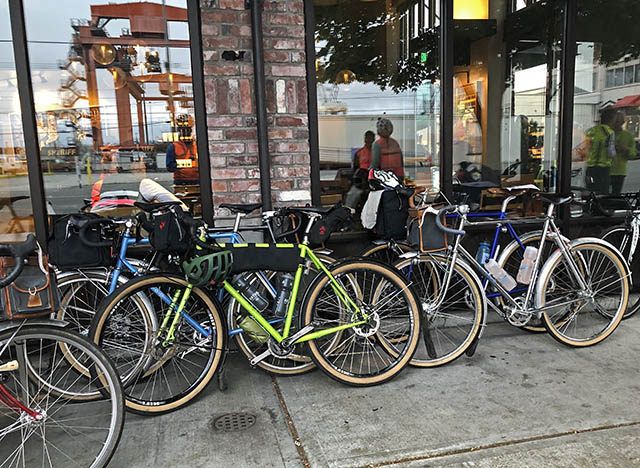
The last of the Seattle qualifiers started at 6 a.m. just south of downtown. It was easy to find the spot – a coffee shop surrounded by bikes leaning against walls, street signs, trees – any available surface. Cyclists were milling around, greeting friends, folding route sheets and placing them in their map holders, taking off layers in anticipation of warming temperatures…
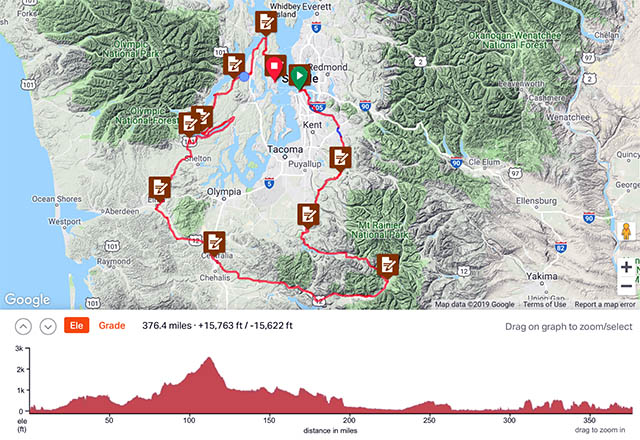
Our course would describe a big loop, first heading south to Mount Rainier, then west almost to the Pacific Ocean. We’d ride north to the foot of the Olympic Mountains and glide along the shores of the Hood Canal. After 300 miles (480 km) on the road, we’d traverse the steep and relentless Tahuya Hills, before ending the ride on Bainbridge Island and returning to Seattle by ferry.
The course offers variety that keeps the riding interesting, from the deep valleys of the Cascades to the sparkling inland waters that make Washington State so special. It’s not a truly mountainous route, but over the course of 600 km, the climbs add up to almost 4800 m (15,700 ft) – about the same ratio of climbing per mile (or kilometer) as Paris-Brest-Paris.
The map above also shows the controls, the checkpoints where we’ll have our brevet cards signed as proof that we’ve completed the course. There is a time limit of 40 hours to finish the ride – and as in all randonneur rides, it’s overall time, not riding time, that counts.

On this Saturday morning, the sky was overcast. By the time we crested the first ridge and headed toward Lake Washington, the sun already made its first attempts to pierce the clouds.

Riding with friends is a great way to cover long distances efficiently – and the conversations make the time pass quickly. We joined other groups from time to time, then split up again. We know each other well after riding together for so many years, and our paceline was smooth, relaxed and safe.

We enjoyed some of our favorite roads that skirt the flanks of Mount Rainier. With no traffic to speak of and a beautiful rhythm, it was fun to push our pace a bit, while being mindful of the long way we still had to go: almost 500 km (300 miles) remained ahead of us.
If I thought about the distance that lay ahead, it might have been a bit daunting, but instead, I focus on the moment during these long rides. Feel my bike, spin the pedals smoothly, time my effort perfectly for the little ups and downs, and enjoy the ride. Listen to my body and keep the pace at a sustainable level. I didn’t think about what was behind or what lay ahead, but instead focused on becoming one with the bike. Shifts happened automatically without me thinking about them. The bike followed the road as I looked in the direction where I wanted to go, without any conscious input. The tires hummed on the pavement, and these early stages of the ride felt effortless.
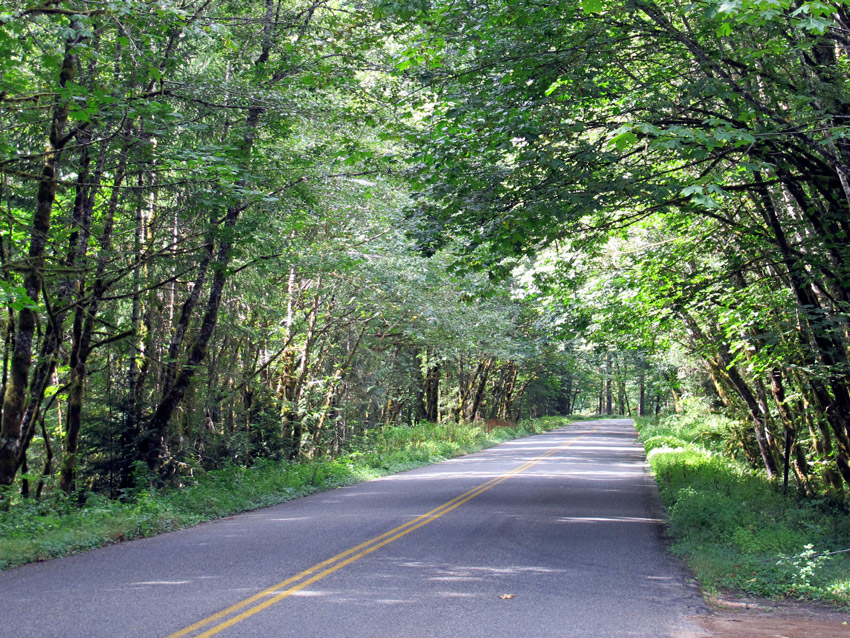
The long climb to Bear Prairie at 2600 ft (800 m) elevation was punctuated by views of Mount Rainier (top photo). The reward for the climb was the wonderful descent on Skate Creek Road. Undulating, with little dips and rises, and sunlight filtering through the trees, this is one of the most wonderful roads. It’s just enough of a descent to go fast while spinning effortlessly. Skate Creek Road is the highlight of any ride, and it didn’t disappoint on this day.

Then we headed west again. There is always a headwind in the Cowlitz River valley: Warm air rises from the lowlands up the slopes of the Cascade Mountains and of Mount Rainier. On this day, the wind was blowing even stronger than usual, and we formed a larger group to work together.
Riding into a headwind for hours can be hard for me. Unlike climbs, headwinds don’t offer rewards. There is no downhill on the other side – the best you can hope for is that the wind will stop. It was nice to be in a group here – the others not only provided shelter, but also encouragement. Plus, it was fun to catch up with others on this ride.
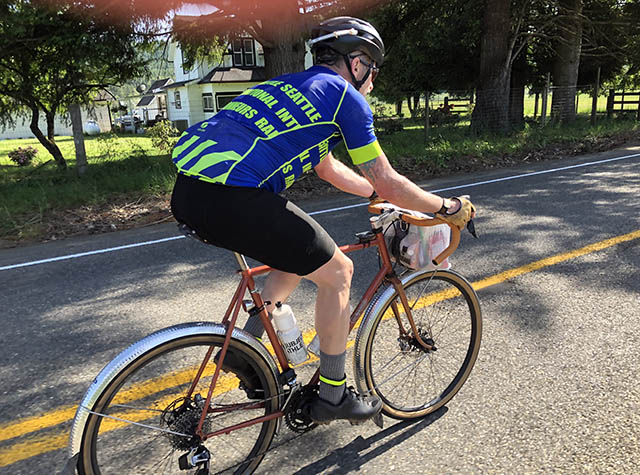
Hahn has entered the Concours de Machines, held in conjunction with PBP this year, and so he’s experimenting with new ideas – including this ultralight, see-through handlebar bag.

At the next control, we split up again. Now it was just Ryan Francesconi and me, forging ahead. We reached the ‘overnight control’ at sunset: Our club rents some rooms in a hotel for those wanting to sleep a few hours. We stopped only briefly, ate bowls of soup, then headed into the night. Our plan was to ride ‘straight through.’ Another control – another gas station – provided an opportunity to refill bottles, stock up on food and stretch briefly, before heading into the night again.
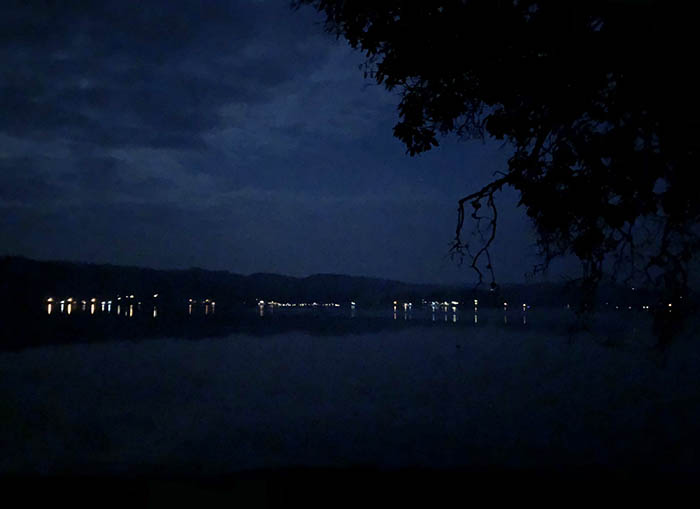
The Hood Canal in moonlight was a beautiful experience. The roads were almost deserted. The lights of the small communities reflected in the water. Night riding really is a lot of fun. There was another control with volunteers in Tahuya – more soup and encouragement – and then it was just us and the night: Now we entered the almost mythical Tahuya Hills.

Climbing the remotest parts of the Puget Sound region at night is a surreal experience. The few houses that dot the landscape are invisible in the dark. The hills seem longer, and yet time passes more quickly. This part of the course has a beautiful rhythm, and I enjoyed it very much.
You’d expect to get sleepy in the middle of the night, but working hard on the uphills is the best way of staying awake, followed closely by the excitement of descending curving roads in the dark. A good headlight with an even beam is a big plus – almost a requirement – for this type of riding. We both welcomed the first signs of dawn with that special feeling of having ridden through the night.
 The sun rose just as we descended into Seabeck. The little town was deserted and the quaint store on the water was still closed. Instead of getting a signature at this control, we answered a question on the control card. With the finish approaching – less than 100 km/62 miles away – we didn’t linger, but pressed on.
The sun rose just as we descended into Seabeck. The little town was deserted and the quaint store on the water was still closed. Instead of getting a signature at this control, we answered a question on the control card. With the finish approaching – less than 100 km/62 miles away – we didn’t linger, but pressed on.

The hardest part of the ride was yet to come: Anderson Hill Road is feared by most cyclists who’ve experienced it. It’s a triple climb that rises like a stairstep, with a vertiginous 18% descent between the first and second step. We crouched in the full aero tuck, hit almost 90 km/h (56 mph) on the descent, and made it up most of the second climb, but there was no momentum to carry us up the third climb: It was just hard work.
It was over quickly: The overall elevation gain is modest, and while harsh, Anderson Hill Road climbs for just a mile. From there, we rode on (hilly) backroads to the finish on Bainbridge Island.

No records were beaten on this windy weekend – we took 26:15 hours to complete the course. The next ferry left just 15 minutes after we arrived, so after the briefest of rests, we rolled down to the harbor – tired, but happy.
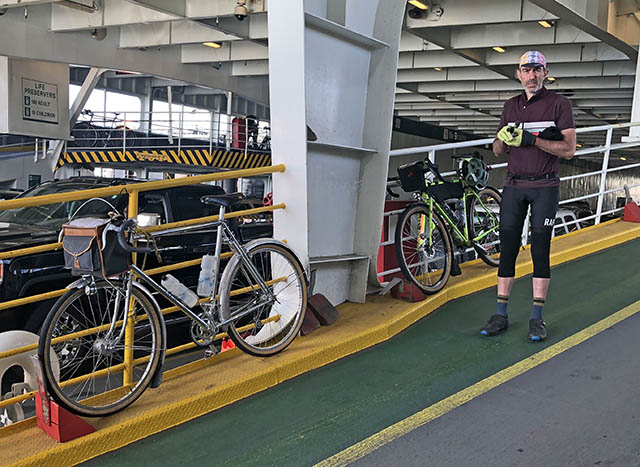
On this Sunday morning, the ferry was full of bikes. Most were heading out for their Sunday rides, while we had just finished ours. We parked our bikes, tied them to the railing, and for the first time in more than a day, the clock no longer was ticking for us. It was as if the world had suddenly switched to slow motion.

As the ferry headed back to Seattle, we climbed upstairs, stretched out on a bench, and enjoyed a restful crossing. Despite – or perhaps because of – the challenge, brevets are fun: They are (mostly) fun on the road; you’re glad when you arrive; and you feel a great sense of accomplishment afterward.
Paris-Brest-Paris is just two months away. Now is a good time to look back over the experience gained from the brevets. Where are our strengths and weaknesses? Do we need to condition our bodies to riding long distances, or do we need to work on our speed? Shall we train on hills, or improve our speed on the flats? Now is also the time to deal with aches and pains that are caused by a lack of flexibility or by muscle imbalances.
This is also the last opportunity to use the experience gained in the brevets and make changes to our bikes. Apart from general maintenance – new tires, gear cables, chain and other wear-and-tear parts – are there parts that could be improved? Like a different handlebar shape to alleviate hand problems? Or a more comfortable saddle? A headlight with a better beam pattern to make night riding less fatiguing? A handlebar bag that makes food and clothes easily accessible while riding? We don’t want to make changes shortly before the big ride – now there still is time to dial in new components and make sure they work flawlessly by the time we line up on the start line just outside of Paris. In the next post, I’ll talk about some of these equipment choices and what has worked well for us.


